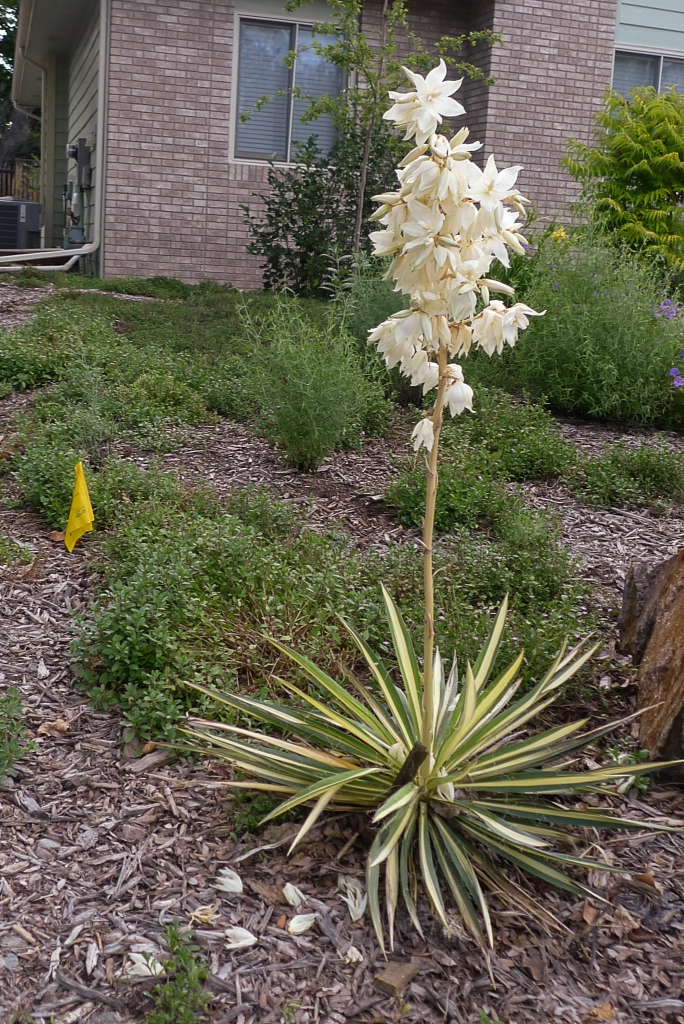
Soapwort flows past a boulder where Steve, my tabby, acts as overseer. Directly behind Steve, you can see bonfire euphorbia just starting to bloom with bits of yellow bracts showing. To the left of the soapwort sits Pawnee Buttes sand cherry, and in the center of the background is orange carpet hummingbird, which will burst forth with neon orange flowers in the next week or two.
While traveling through Louisiana years ago, I was amazed by the sheer lushness of the trees, grass and flowers.
Here in Colorado, I rarely spot lush residential landscapes. What can you expect in such an arid climate? All the same, I love luxuriant gardens in which plants simply flow into each other.
Most trees and shrubs, by their very nature, offer a degree of lushness, which is why homeowners love them. But groundcovers can add a whole new level of richness.
I’ve been experimenting with various low-water groundcovers to create a sense of lushness in my Fort Collins landscape. It has taken about four years to get close to achieving the sumptuousness I’m looking for, but I’m making progress. I’ve propagated new plants from existing ones to keep costs down.
My goal has been to provide successional bloom; in other words, have something new flowering throughout the season for aesthetics and for pollinators.
Here are plants I’ve used successfully.
Spring bloomers
Woolly speedwell (Veronica pectinata). One of my all-time favorites, woolly speedwell offers an evergreen carpet for flowering bulbs in early spring. Then around April or May, small blue blossoms emerge on this ground hugger, creating a spectacle of color that lasts for three or four weeks. Although drought tolerant, woolly speedwell performs best in part shade with regular watering. To propagate it, dig up a chunk and move it where you need it.

Bloody cranesbill is one of the toughest groundcovers I’ve ever grown. It thrives in both sun and shade, offering a flush of bright fuchsia flowers in the spring.
Soapwort (Saponaria ocymoides). This sun-loving, evergreen beauty begins blooming in late spring and continues into early summer with a profusion of perky pink flowers. There’s a white-flowered soapwort, as well. Soapwort reseeds prolifically, covering a significant amount of real estate in a short time. Many web sites claim that soapwort spreads 15 to 18 inches. Don’t believe it. Some of my pink bloomers routinely grow 40 inches wide and eight inches high. If you want to discourage soapwort’s spread, simply pull off the seed heads.
Candytuft (Iberis sempervirens). Candytuft resembles a wedding bouquet with its profusion of white blooms. The plant’s attractive deep green leaves keep their color year-round. This underused plant begins flowering in late spring and extends well into June. Candytuft will grow about two feet wide. You can divide it for more plants.
Summer bloomers
Bloody cranesbill (Geranium sanguineum). An early summer bloomer, bloody cranesbill produces bright fuchsia blooms in both sun and shade. After its initial flush of flowers, this groundcover will continue to produce occasional blooms throughout the growing season. It grows about 14 inches high and 36 inches wide, and is extremely drought-tolerant. Propagate it by division.
Rozanne cranesbill (Geranium ‘Gerwat’ Rozanne). Rozanne is Bloody’s cousin with bigger, longer-lasting blooms. In my garden, Rozanne grows about 20 inches high and 36 inches wide, and explodes with two-inch-wide purple blossoms from June till September. Like bloody cranesbill, Rozanne will grow in both sun and shade, and can be propagated by division. Although drought-tolerant, Rozanne prefers regular watering.

Sumptuous Rozanne cranesbill provides purple blooms from June till September.
Prairie winecups (Callirhoe involucrata). This hardy groundcover sends out 30-inch runners loaded with rich magenta goblet-shaped blooms. Winecups begins blossoming in late May and keeps on going till frost. The easiest way to propagate prairie winecups is by seed.
Bonfire euphorbia (Euphorbia epithymoides ‘Bonfire’). I’ve loved this mounding plant ever since spotting it at the Colorado State University perennial trial garden years ago. Its showy red/orange/purple foliage makes this plant a show-stopper throughout the growing season. But when it blooms, whoa Mama! Bonfire’s brilliant yellow bracts grab the attention of passers-by, who often pause and ask questions about the plant. Although often described as a groundcover that grows 18 inches wide, my four-year-old bonfire is 30 inches wide and 14 inches high.

Meidiland groundcover roses perform spectacularly in the garden, especially in hot, dry areas. This fire meidiland, with its double blooms, is a show-stopper.
Groundcover roses. My favorite groundcover roses are the meidilands, which come in red, pink, yellow and white. These ground-hugging, weed-squelching stalwarts thrive in the hottest, driest growing conditions and feature stunning, deeply colored blooms. I favor fire meidiland, in particular, with its lush double blooms, but have also grown red meidiland successfully. Another delightful groundcover rose is seafoam, a white variety that grows in the White House rose garden. My only caveat with white roses is that they’ll turn brown if you grow them in sun that’s too intense. The roses bloom from June till frost. Groundcover roses are easy to propagate by simple layering.
Hardy plumbago (Ceratostigma plumbaginoides). This gorgeous plant will grow in sun or shade. I like growing it under trees. It’s drought tolerant, but grows best with regular watering. In July, plumbago delivers striking gentian blue flowers, followed by lovely copper-colored seed heads. Then in the fall, the foliage turns red. Plumbago spreads readily by itself, but you can encourage it by digging up a chunk to plant where you need it.
Fall bloomers
Except for bloody cranesbill and bonfire euphorbia, all of the summer bloomers mentioned above continue flowering through the fall. Another summer/fall bloomer is orange carpet hummingbird (Zauschneria garrettii).
Groundcovers act as organic mulches that save you time and money you might otherwise spend on wood and rock mulches. If you haven’t used groundcovers on a large scale, I encourage you to try them.


















